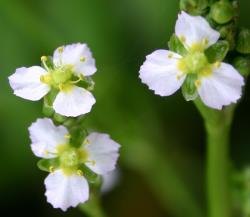Perennial, mostly emergent glabrous aquatic herbs, rhizomes short, stout, bulb-shaped; leaves from a basal rosette. Hermaphrodite. Stolons absent. Roots fibrous, non-septate. Leaves petiolate, erect, floating or submersed; leaf-bases cuneate or weakly lobed. Petioles open-sheathing, adaxially winged. Inflorescence a whorled panicle of many flowers, bracteate. Flowers perfect, pedicellate. Androecium 6(–9) stamens in pairs in one whorl; filaments filiform, glabrous; anthers basifixed, latrose dehiscence; staminodes absent. Gynoecium with many free carpels in a single whorl on a flattened receptacle; style gynobasic (appearing lateral on the ventral side); ovule placentation basal. Fruit a laterally compressed obovate achene, dorsally 1–2 ribbed, beaked, without wings. Seed uncinate, surface smooth to rugose, non-glandular, without hairs.
| 1 | Leaf-laminae broad-ovate or elliptic, base obtuse to cordate; petals rounded apically and denticulate; fruiting head cluster with a central gap | plantago-aquatica |
| 1' | Leaf-laminae narrow lanceolate or elliptic, base cuneate; petals acute or acuminate apically; fruiting head cluster with no central gap | lanceolatum |
The two species of Alisma in New Zealand have distinctive, plantain-like rosettes of erect leaves and a large, open, pyramid-shaped leafless inflorescence of many small, pale pink or lilac flowers.
About 11 species in temperate and subtropical regions of the world (Wang et al. 2010): Eurasia, Central Asia, China, Japan, north Africa, North America, Australia (Björkqvist 1968, Jacobs & McColl 2011, Conran 2012).
In New Zealand one species tends to predominate regionally, which cannot be entirely explained by latitude. Notable is the absence of Alisma lanceolatum from Northland, Gisborne, Taranaki and Waikato, as it is described in Europe as being more thermophillic than A. plantago-aquatica (Björkqvist 1967). Both species are widespread but scattered in distribution, A. plantago-aquatica occurs from Northland to the Clutha District in southern Otago, and A. lanceolatum recorded from Auckland to Southland. Also notable is the absence of records of either species from Westland, given the abundant habitat availability, open drains and ditches in lowland cultivated areas. The Taieri Plains in Otago appears to be the only location where both species are commonly present in the same water system.
| Category | Number |
|---|---|
| Exotic: Fully Naturalised | 2 |
| Total | 2 |
n = 7 is regarded as basic (Björkqvist 1968); there are diploid, tetraploid and hexaploid species. Björkqvist (1967, 1968) reported that stoma length equates to ploidy level.
Both species of Alisma in New Zealand are recorded by Björkqvist (1968) as cross-pollinating and self-fertile (facultative allogamic), reproducing by seed and vegetative by shoots and rhizomes. In Europe, natural hybrids have been documented between Alisma plantago-aquatica and A. lanceolatum and confirmed by progeny from artificial hybridisation with high but not absolute sterility (Björkqvist 1968). Pogan (1961, 1971) has reported various levels of fertility in hybrids. In New Zealand one instance of hybridisation (OTA 62553) has been reported from the Sinclair Wetlands in Otago, where both parent species occur.
Healy & Edgar (1980) treated Alisma in New Zealand. No additional species are reported here, and there has been little change in distribution since then.




